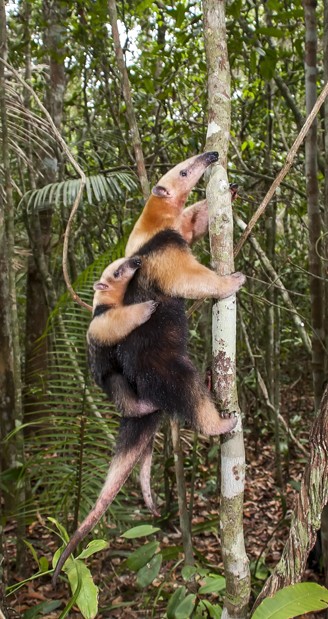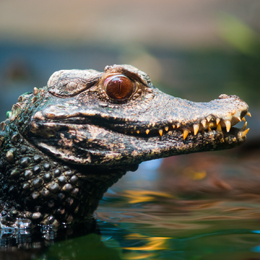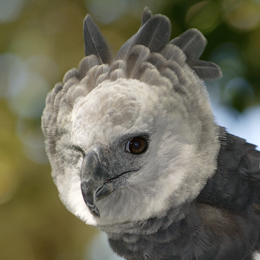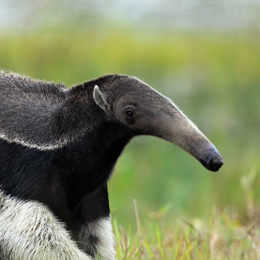Southern Tamandua
Native to South America, the Southern Tamandua is a species of anteater that is mostly seen in forests and grasslands. The word ‘Tamandua’ roughly translates into ‘insect eater’ which hints at the primary diet of this animal. It is medium sized and smaller than its closest relative, the Giant Anteater, due to which it is nicknamed as Lesser Anteater. The Southern Tamandua is also known as Collared anteater in some places and is found in large numbers in Venezuela, Trinidad, northern Argentina, Uruguay and southern Brazil at elevations up to 2000 meters.
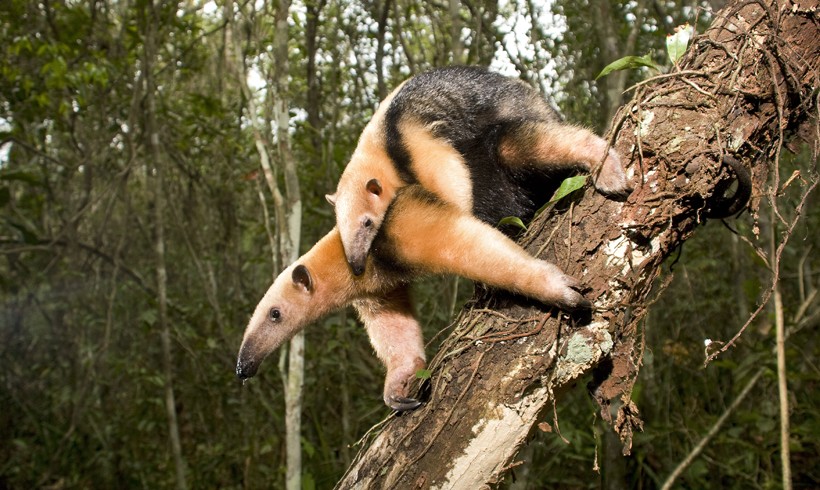
Southern tamandua walking on a branch
?
Image credits: Leonardo Mercon/Shutterstock
The anteater inhabits wet as well as dry forests and also lives in the savanna, tropical rainforests and thorn scrub. This anteater is mostly found near rivers and streams that are covered with epiphytes and vines because of large availability of prey that mainly includes ants and termites.
The size of the Southern Tamandua often varies depending on environmental conditions. It has a long snout and the length of the body and head can be between 34 to 88 cm (13 - 35 inches) long. The mammal has a prehensile tail that has been measured up to 37 – 67 cm or 15 – 26 inches. An adult tamandua can weigh between 1.5 – 8.4 kg (3.3 – 18.5 lbs) which makes it a considerably smaller anteater compared to the Giant Anteater which weighs between 27 – 41 kg (60 – 90 lbs). Their body is covered with pale tan or blond fur with their shoulders marked with black fur that forms the shape of a vest. The male and female of this species have no significant differences either in size, weight or appearances, which makes it difficult to identify the male and female Southern Tamanduas visually. The average lifespan of this anteater is 9 years and it attains sexual maturity at an age of 1 to 3 years.
Subspecies and Relatives
The Southern Tamandua has four subspecies:- Tamandua tetradactyla nigra
Identified in 1803 by the French naturalist Geoffroy, this subspecies is widely distributed in Colombia, Venezuela, Trinidad and the regions of Guiana and northern Brazil.
- Tamandua tetradactyla quiche
The T. t. quiche was first identified in 1927 by a British zoologist and is found in extreme western parts of Brazil, Peru and Ecuador.
- Tamandua tetradactyla straminea
This anteater was first identified in 1889 and its location mainly includes the southern part of Brazil, Argentina, Bolivia and Paraguay.
- Tamandua tetradactyla tetradactyla
This subspecies is found in Brazil and Uruguay.
Besides the above-mentioned subspecies, the Southern Tamandua has a northern relative called Northern Tamandua that occupies the areas of southern Mexico, Central America and the Northern Andes. Its scientific name is Tamandua mexicana and thus belongs to the same genus as the Southern Tamandua. Regarding their appearance, the Southern and Northern tamandua are quite similar except for the distinction of the edges of the vests that appears to be sharply distinct in the Northern Tamaduas but somewhat blurry in its Southern counterpart.
In addition to the Northern Tamanduas, this anteater is also considered to be a close relative of the Giant Anteater which is found in the temperate rainforests and grasslands of Central and South America and are considerably larger than the Southern Tamandua. Additionally, the Silky Anteater of the genus Cyclopes is another species of anteaters that has a close relation with the Southern Tamandua. It is arboreal in nature and is the smallest of all anteaters with a body that is almost equal to the size of an adult squirrel.
Identified in 1803 by the French naturalist Geoffroy, this subspecies is widely distributed in Colombia, Venezuela, Trinidad and the regions of Guiana and northern Brazil.
The T. t. quiche was first identified in 1927 by a British zoologist and is found in extreme western parts of Brazil, Peru and Ecuador.
This anteater was first identified in 1889 and its location mainly includes the southern part of Brazil, Argentina, Bolivia and Paraguay.
This subspecies is found in Brazil and Uruguay.
Anatomy and Characteristics
The Southern Tamandua has no teeth but has a disproportionately long snout along with a rounded tongue. They can stick out their narrow tongue up to a length of 40 cm. The entire length of the tongue is coated with a pasty, sticky saliva and is covered with tiny posteriorly directed spines. This anteater has five fingers out of which three have large claws that can be as long as 16 inches.
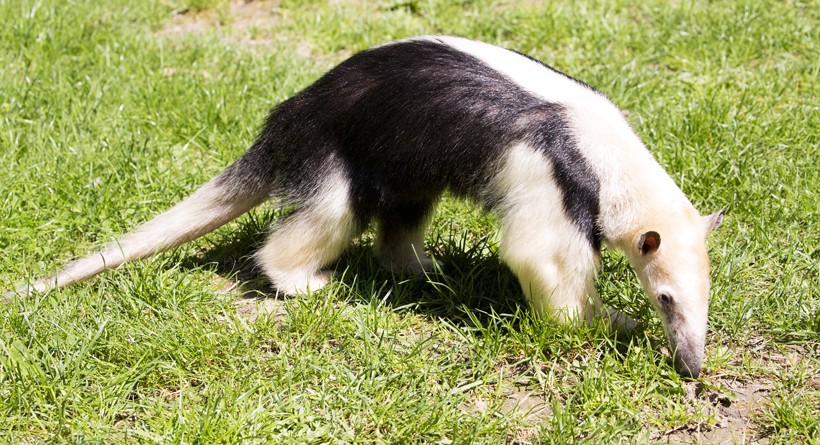
The Southern Tamandua has a 40 cm long tongue but doesn't possess any teeth.
?
Image credits: Vladislav T. Jirousek/Shutterstock
They perform their walking by supporting their body on the wrists in order to keep their claws in shape and avoiding thus to be hurt by their own claws. The toes of the hind legs are also elongated which provide an improved grip when climbing up on the trees. They have four short, but muscular feet. When they walk on the surface their long tail drags along rather than being held upright.
The tail of an adult Southern Tamandua measures around 50-53 cm, which greatly helps the tamandua in tightly gripping the tree branches. The tip of the tail is hairless and is blotched with a brownish black or pinkish-yellow color. Their coat is coarse and thick and the color can vary from yellow to dark brown. The black fur in their coat forms a vest that is seen in many Southern Tamanduas. However, the tamanduas that are found in northern Brazil, Venezuela and the west part of the Andes are seen with a coat of solid blonde, dark brown or black fur and are only lightly vested.
The brain is very small in size and their stomach has a strong pyloric portion that helps in digesting the insects efficiently. Both their eyes and ears are rounded and the long snout is decurved in such a way that opening of it is limited: only small items with a diameter of a small stick fits.
Habitat
The Tamandua tetradactyla inhabits the forested regions of South America, including Venezuela, Northern Argentina, Trinidad and the eastern part of the Andes. Their habitat varies from dry grasslands to temperate rainforests, thorn shrubs and savannas. They are found commonly near rivers and streams with many vines.
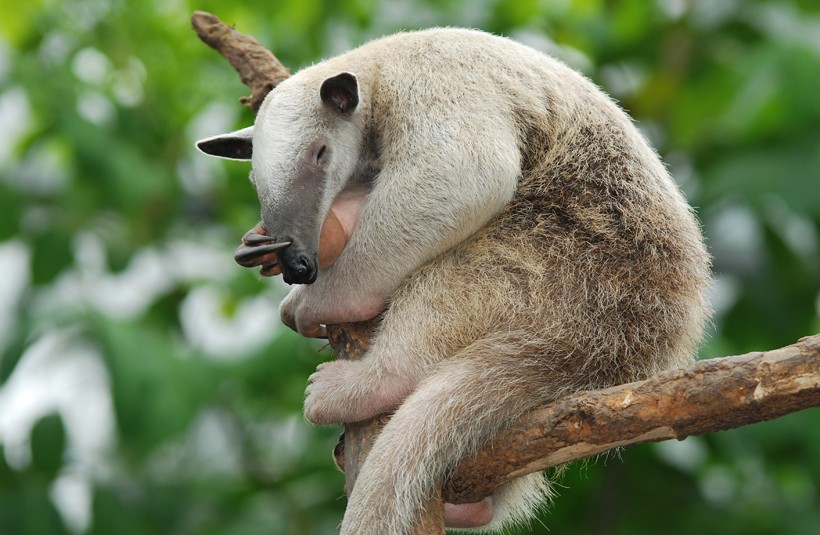
Southern tamandua resting in a tree
?
Image credits: Karel Gallas/Shutterstock
Recent studies on the habitat choice of the Southern Tamanduas revealed that they either choose to live in forest edges or forested habitats regardless of the landscape or topography with the open grasslands being their least preferred choice.
The average size of their territory ranges from 350 to 400 hectares. Foraging is carried out in the open areas whereas they spend a major portion of their time in trees. In fact, it has been found that the Southern Tamanduas spend 60 % of their entire time either foraging in trees or resting among branches. They usually find shelter in hollow trees and in the absence of proper tree hollows, they might also use abandoned ground holes as shelters.
Diet, Hunting, Predation
Diet
The diet of the Southern Tamandua is very special. Termites and ants are their primary prey but they have also been seen eating fruits in very small quantities. They prey on different species of ants and termites that mostly includes carpenter ants, army ants and Nasutitermes. As anteaters are not immune to the sting of ants equipped with chemical defense systems, they avoid preying on leaf-eating ants or termite soldiers. Some studies suggest that Southern Tamanduas may also eat honey and particular species of bees if the opportunity appears. In captivity, it is observed that these anteaters have eaten equal portions of fruit and meat.
Hunting
The small eyes of the Southern tamanduas provide them with only poor vision. However, this is compensated by their long snout that intensifies their sense of smell. They detect prey by following their scent and once detected a nest of insects, they usually dig a hole in the nest with their sharp fore-claws resulting in displacement of the insects. After digging they move their long cylindrical tongue around it as fast as 150 times per minute and ingest the prey along with the larvae and cocoons.
The insects get stuck on the extremely sticky tongue where after they get crushed almost immediately at the hard palate before getting swallowed. However, the ambushed nest gets only partially damaged and these anteaters spend hardly 60 seconds per nest. They consume almost 9000 ants every day which fulfills also their water requirement.
Predation
The jaguar, margay, puma and cougar are some of the strong predators that might hunt down a Southern Tamandua easily if discovered in an open area. However, as this anteater spends most of its time among trees, they remain easily hidden among the thick branches and leaves. The cryptic camouflage helps this anteater to blend greatly with their surrounding environment and therefore is also its primary self-defense against the predators. The black marking on the fur provides an added advantage in the low light areas of the forests. As gentle animals that remain quiet most of the time, the Southern Tamanduas always approach conflicts in a passive manner. However, when they find themselves under threat, they outstretch their forelegs with the sharp claws by standing on their short hind legs. They use their claws to make a rapid hook-like movement in an attempt to drive away their predators. During self-defense, they have been seen gripping tree branches with their tail for obtaining improved balance. Besides feline predators, the Southern Tamanduas might also get attacked by hawk and harpy eagles that are native to South America.
Reproduction and life cycle
There is very little information on the courtship behavior and reproduction of the Southern Tamandua as it has not been studied widely yet. However, based on the few studies that have been made so far on the life cycle of Tamandua tatradactyla, scientists have put forward two theories. One of the theories suggests that the young ones are born between the month of March and May because of the plentifully available food during that period. The other theory claims that females are capable of breeding throughout the year which makes them characteristically polyestrous. Even so, mating is assumed to occur during the fall months.
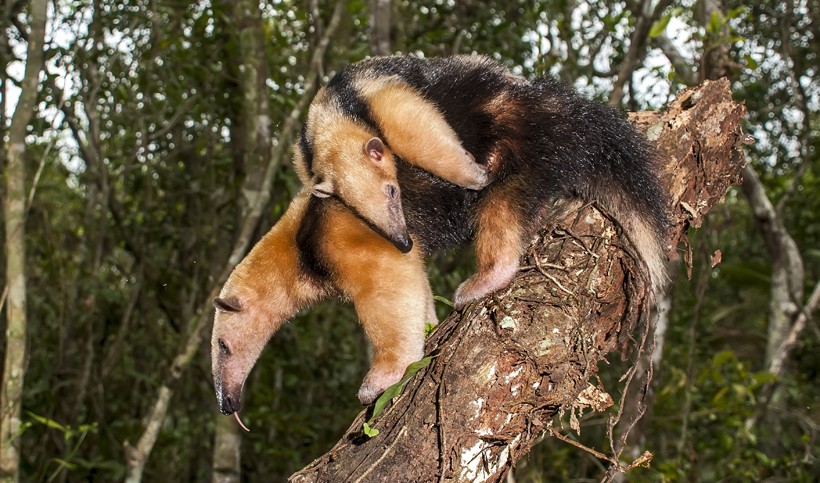
Southern tamandua mother with child on her back
?
Image credits: Leonardo Mercon/Shutterstock
The gestation period can last 130 – 190 days after which a single young is born (twins are very rare). While giving birth, the Southern Tamanduas stand on the hind legs and use their tail as an added support. The mother often consumes the placenta after the young one is born. The young ones have no resemblance to their parents as their body is covered with either a white or black coat. Adult markings also remain absent from the body of the young ones. The females of this species usually attain sexual maturity by the age of 1 - 3 years but some studies suggest that they become capable of breeding only after two years of age.
The females of the Southern Tamandua provide a good deal of postnatal care to their young ones that are often seen being carried on the back of the mother. During the time they travel on the back of their mother, the young ones learn the various survival aspects, the tactics of locating food sources and gradually adopt the dietary preferences of their mother. After about a month, the young tamanduas become able to walk on their own and after 12 months they become independent and start to hunt and move around on their own.
Behavior, Communication and Intelligence
Inherently, Southern Tamaduas are solitary species. They don’t have any nest or constant nesting place and can display both nocturnal and diurnal characteristics. They move slowly and remain active only for about eight hours every day with the rest of the day being spent resting. Their slow and minimum amount of movement is caused by their diet and low metabolic rate.
The tamanduas have rather low body temperatures that range between 32.7 – 35 ͦC (91 – 95 ͦF) which helps them to deal with the limited amount of energy content that they gain from their tiny prey. Although these mammals are capable of both digging in the ground as well as climbing trees, this species of anteater spend most of its time in the trees and seems more comfortable in climbing trees rather than walking on the ground.
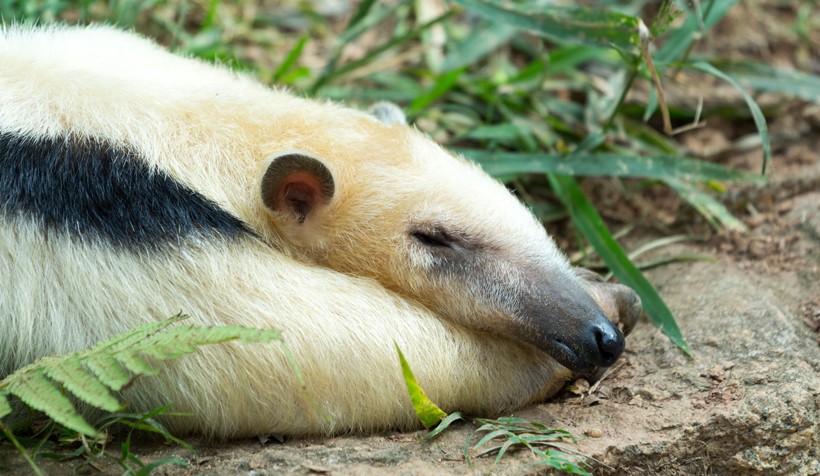
Southern Tamandua taking a nap after lunch
?
Image credits: Fabio A B Fernandes/Shutterstock
The primary way of communication among the tamanduas is through smell. Their anal glands produce a special secretion that has a very strong distasteful smell. They use this secretion to mark trees, paths or any conspicuous object and also to advertise their presence, status and sexual condition to the opposite sex. Sometimes they use this stench for marking their territorial boundary. The Southern Tamanduas are very quiet animals and make sounds only during fights which can be heard in the form of snorts, hisses, roars and sniffs. On the other hand, during the postnatal care, the young tamanduas often make a high-pitched grunting noise to communicate with their mother.
Population and conservation
The exact number of Southern Tamanduas that resides in the wild habitats of South America is not known but this species is listed in the category of Least Concern on the IUCN’s Red List of Threatened species. Although they are widespread, Southern Tamanduas are pretty uncommon and are not found anywhere else except the wild forests of South America.
Cultural depictions
As the Southern Tamanduas are not seen commonly around human settlements they are not depicted in cultural human societies as the Giant Anteater is, which is terrestrial by nature and seen more frequently than the tamanduas. However, tamanduas often get killed by hunters for their thick tendons present in their tail which is used in making rope. Besides this, some Amazonian Indians capture tamanduas and take them to their homes in order to rid themselves from ants and termites.
Evolutionary history
The oldest fossil records of Southern Tamandua date back to the Pleistocene Epoch of South America. Their genetic evidence hints that the present form of the tamanduas may have evolved from their larger relative, the Giant Anteater, from which they might have diverged almost 12.9 million years ago at the end of the Miocene period.
Funfacts
- The Southern Tamandua feeds mainly on ants and termites and spends almost 60 % of their time in trees.
- Also known as lesser anteater, the Southern Tamandua has a 40 cm long tongue but doesn't possess any teeth.
- The Southern Tamandua has a long prehensile tail that is used almost like a fifth limb during standing and climbing trees.
- The species of Southern Tamandua locates its prey with the help of smell as it has very poor eyesight but extremely sensitive nose.
- The Southern Tamandua hardly makes sounds unless it is threatened or indulges in a fight.
